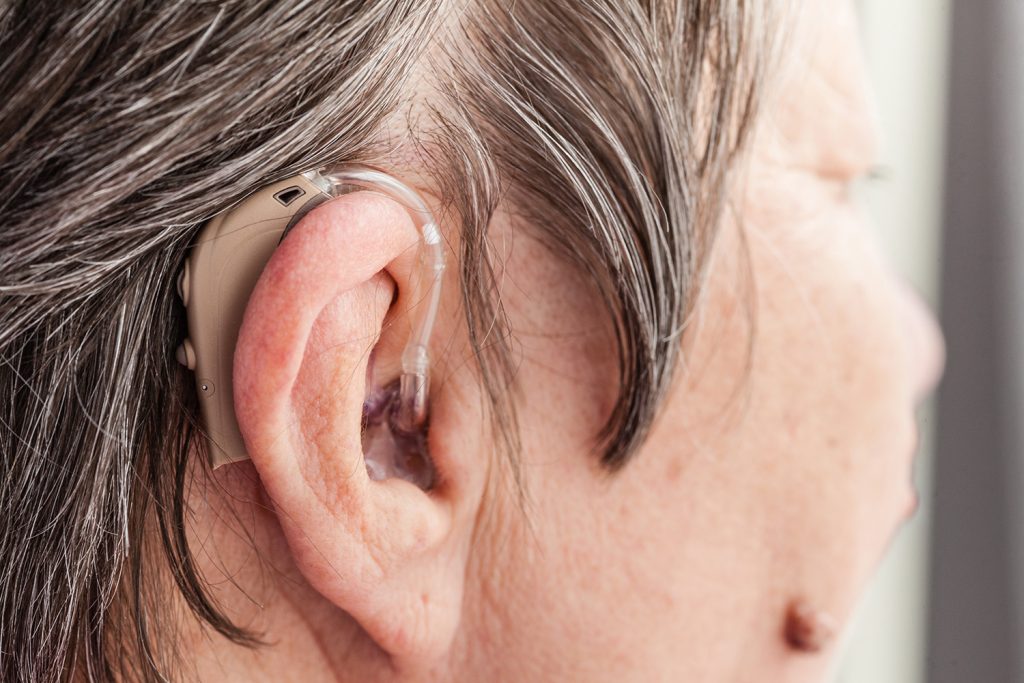Conductive hearing loss is a type of hearing loss that occurs when there is a problem in the outer or middle ear that prevents sound from being conducted to the inner ear. This type of hearing loss can range from mild to severe and can be temporary or permanent, depending on the cause. Some common causes of conductive hearing loss include:
Earwax Blockage: One of the most common causes of conductive hearing loss is earwax blockage. Earwax is a natural substance produced by the body to protect the ear canal, but if it becomes impacted, it can block the ear canal and cause hearing loss. The blockage can be removed by a doctor or an audiologist, and once it is removed, hearing should return to normal.
Otitis Media: Another common cause of conductive hearing loss is otitis media, which is an inflammation of the middle ear. This condition is often caused by a bacterial or viral infection and can result in fluid buildup in the middle ear, which can interfere with sound transmission. Otitis media is most commonly seen in young children, but it can occur at any age. The treatment for otitis media depends on the cause, but typically involves antibiotics for bacterial infections and decongestants for fluid buildup.
Perforated Eardrum: A perforated eardrum is a tear or hole in the thin membrane that separates the middle ear from the outer ear. This can be caused by an injury, such as a blow to the ear or exposure to loud noises, or by inserting objects into the ear canal. A perforated eardrum can cause hearing loss because sound cannot be transmitted through the damaged membrane to the inner ear. In some cases, a perforated eardrum can heal on its own, but in other cases, surgery may be necessary to repair the damage.
Foreign Object in the Ear: Another cause of conductive hearing loss is the presence of a foreign object in the ear canal. This can be anything from a small insect to a piece of cotton or a bead, and it can cause hearing loss by blocking the ear canal. In most cases, the foreign object can be removed by a doctor or audiologist, and once it is removed, hearing should return to normal.
Benign Tumors: Benign tumors, such as osteomas or exostoses, can also cause conductive hearing loss. These tumors are growths that develop in the ear canal or middle ear and can block the transmission of sound to the inner ear. In some cases, these tumors can be removed surgically, but in other cases, they may require a more complex procedure, such as an ear reconstruction.
Malformation of the Outer Ear, Ear Canal, or Middle Ear Bones: Another cause of conductive hearing loss is a malformation of the outer ear, ear canal, or middle ear bones. This can be due to genetics, congenital conditions, or injury, and it can prevent sound from being conducted to the inner ear. In some cases, surgery may be necessary to correct the malformation and restore hearing.
Fluid Buildup in the Middle Ear: Fluid buildup in the middle ear can also cause conductive hearing loss. This can occur as a result of an ear infection, an allergy, or a blockage in the Eustachian tube, which connects the middle ear to the throat. The fluid can interfere with sound transmission and cause hearing loss. In most cases, the fluid will eventually drain on its own, but in some cases, medication or a procedure to drain the fluid may be necessary.
Damage to the ear due to injury or noise exposure is another cause of conductive hearing loss. A blow to the head or exposure to loud noises can damage the delicate bones in the middle ear, preventing them from transmitting sound to the inner ear. This type of conductive hearing loss can be temporary or permanent, depending on the severity of the damage. In some cases, surgery may be necessary to repair the damage and restore hearing. Additionally, repeated exposure to loud noises can cause gradual hearing loss over time, which can also be classified as conductive hearing loss. To prevent this type of hearing loss, it’s important to protect your ears from loud noises and to limit your exposure to them. Wearing earplugs or other protective devices can help reduce the risk of noise-induced hearing loss.
How Can Hearing Aids Help Patients With Conductive Hearing Loss?

Hearing aids can be an effective solution for many patients with conductive hearing loss. Conductive hearing loss occurs when there is a problem in the outer or middle ear that prevents sound from being conducted to the inner ear. Hearing aids can help by amplifying sound and delivering it directly to the inner ear, bypassing the damaged part of the ear.
There are different types of hearing aids available, including behind-the-ear (BTE) hearing aids, in-the-ear (ITE) hearing aids, in-the-canal (ITC) hearing aids, and completely-in-the-canal (CIC) hearing aids. The type of hearing aid that is best for a patient with conductive hearing loss depends on several factors, including the severity of the hearing loss, the type of hearing loss, and the individual’s lifestyle and preferences.
Behind-the-ear hearing aids are the most commonly used type of hearing aid and are suitable for patients with a range of hearing losses, including conductive hearing loss. BTE hearing aids consist of a small plastic case that sits behind the ear and a custom-fit earmold that fits into the ear canal. Sound is amplified by the hearing aid and delivered to the ear through the earmold.
In-the-ear hearing aids are another option for patients with conductive hearing loss. ITE hearing aids are larger than ITC or CIC hearing aids and fit directly into the outer ear. They are easy to use and can be adjusted for different listening situations, but they may be more visible than other types of hearing aids.
In-the-canal hearing aids are a smaller, less visible option for patients with conductive hearing loss. ITC hearing aids are custom-fit to the individual’s ear canal and are designed to be worn inside the ear canal. They are less visible than ITE hearing aids, but they may not be suitable for patients with severe hearing loss.
Completely-in-the-canal hearing aids are the smallest and least visible type of hearing aid. CIC hearing aids are custom-fit to the individual’s ear canal and are designed to be worn completely inside the ear canal. They are a good option for patients who want a discreet hearing aid, but they may not be suitable for patients with severe hearing loss or for those who have trouble handling small objects.
Regardless of the type of hearing aid chosen, all hearing aids can help patients with conductive hearing loss by amplifying sound and delivering it directly to the inner ear. This can help improve speech understanding and make it easier for patients to participate in daily activities, such as conversations with friends and family, work meetings, and leisure activities.
In addition to amplification, many hearing aids also come with advanced features, such as directional microphones, noise-reduction technology, and Bluetooth connectivity. These features can further enhance the listening experience for patients with conductive hearing loss and make it easier for them to understand speech in noisy environments.
It’s important to note that hearing aids are not a cure for conductive hearing loss. They can help improve hearing, but they cannot repair the damage to the ear that is causing the hearing loss. In some cases, surgery may be necessary to repair the damage and restore hearing. In other cases, the hearing loss may be permanent and hearing aids may be the only solution.
Hearing aids can be an effective solution for many patients with conductive hearing loss. There are different types of hearing aids available, including behind-the-ear, in-the-ear, in-the-canal, and completely-in-the-canal hearing aids.




